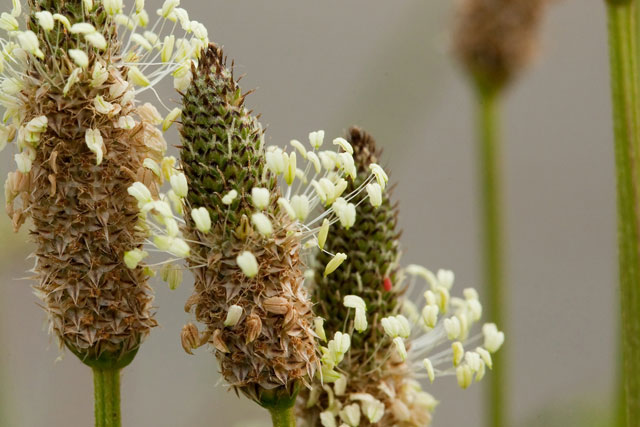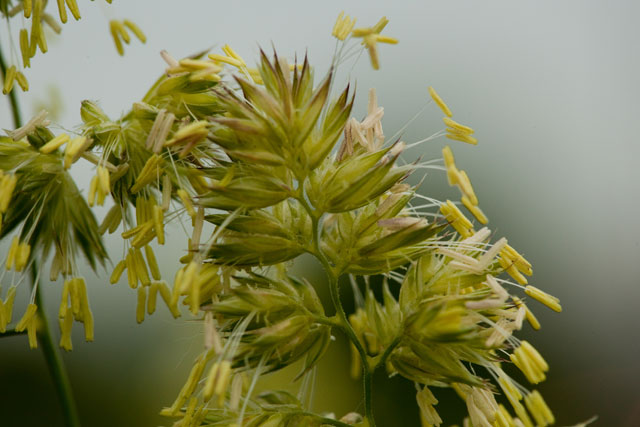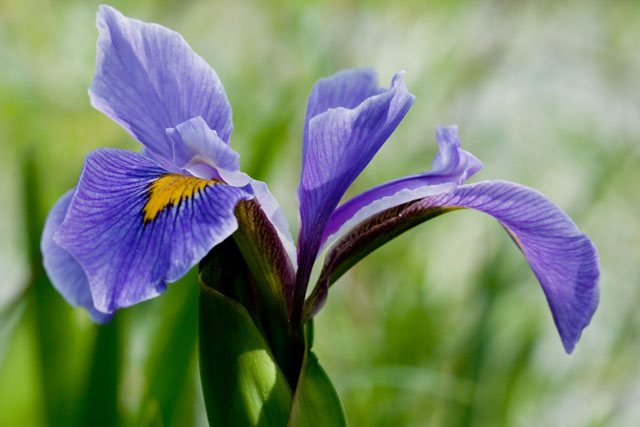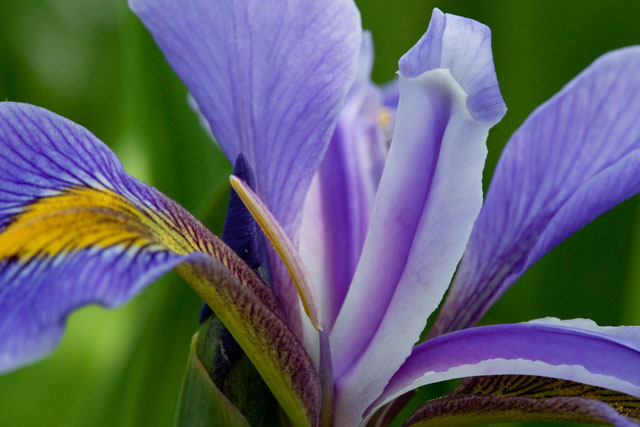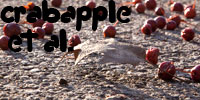 |
 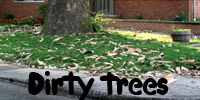 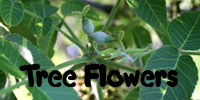 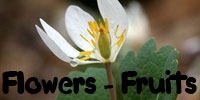 |
Welcome
to bobklips.com, the website of Bob Klips, a plant enthusiast living in
Columbus, Ohio. Rattlesnake fern has huge sporangia!
Delaware County, Ohio May 26 and June 7, 2009 Rattlesnake fern, Botrychium virginianum, is an especially large, common, and early-sporing type of grape fern. It is named for the tightly branched rattle-like cluster of spherical sporangia. The lower portion of the leaf is quite lacy (thrice-compound). 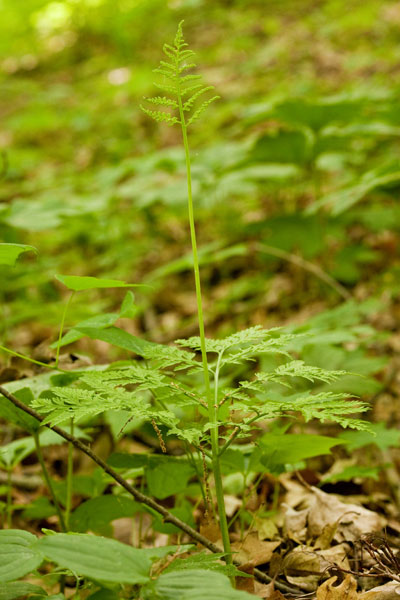 Rattlesnake-fern. May 26, 2009. Delaware County, Ohio. The "grape
ferns" (genus Botrychium in the
"succulent fern" family Ophioglossaceae) are unlike most other
ferns.
They don't develop the familiar fernish (fernish?) coiled-up bud known
as
a "fiddlehead," as the leaves spring up straight from the
soil. Their spore
cases (sporangia) are found not on the undersurfaces of
normal-appearing leaves, but in
terminal portions of the leaf devoted entirely to spore production.
(Several other ferns do that too.) Most distinctively,
however, the grape ferns bear sporangia that are especially large,
indeed reminiscent of a cluster of grapes.
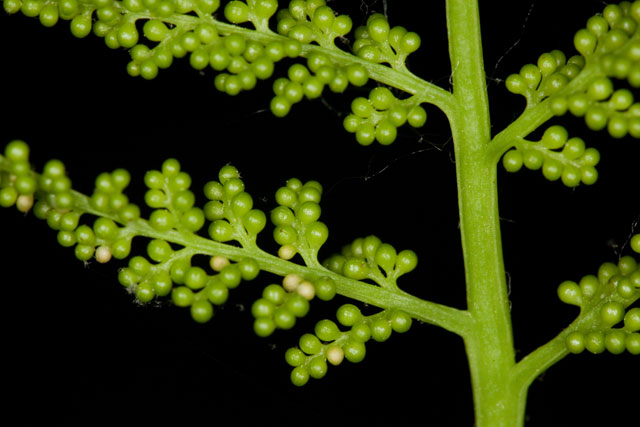 Rattlesnake-fern sporangia. May 26, 2009. Delaware County, Ohio. Another distinctive succulent fern trait is the manner in which the sporangia dehisce (open) to release the spores. They open by a transverse slit. This is regarded as a primitive character, as it is a simpler structure than that of most other ferns, which have a belt-like annulus that splits the sporangium and often hurls the spores as well. Here's what the rattlesnake fern sporangia look like now that they are opening. Note the slits. 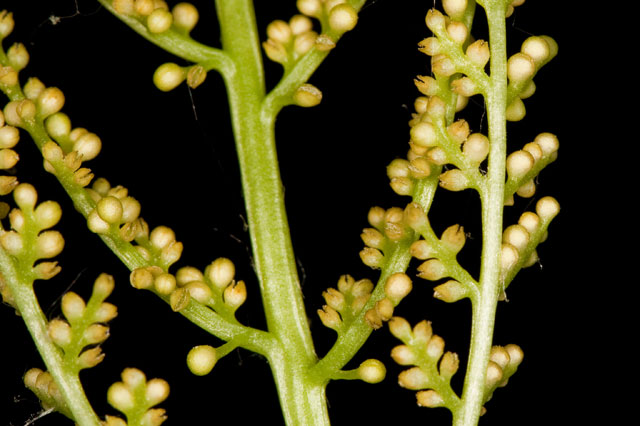 Rattlesnake-fern sporangia. June 7, 2009. Delaware County, Ohio. Violet's hidden marriage...to herself! (himself?) (cleistogamous flowers of Viola) Highbanks Metro Park, Delaware County, Ohio May 28-29, 2009 The springtime violet (genus Viola,
family
Violaceae) flower is showy, with large
colorful petals. Perched upon a wiry leafless stalk, it has a
striking bilateral symmetry. An
expansive lower petal serves as a bee landing
platform, while
lateral petals confine the visiting insect to a path that encourages
the
collection and deposition of pollen. Purple veins serve as "nectar
guides."
Here's one, the downy yellow violet, Viola pubescens, as it appeared in a Delaware County, Ohio, woods approximately three years and six weeks ago. Note at the bottom of the photo there is a flower bud, with the colorful corolla (petals) just beginning to poke out from the protective calyx (sepals). 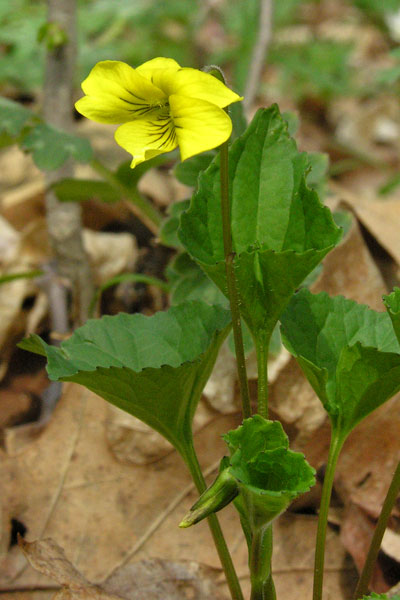 Downy yellow violet in spring. Delaware (Ohio) Wildlife Area. April 16, 2009. Here's downy yellow
violet as it appears now, conspicuously bearing
fruits from the early spring flowers -- dry capsules filled with fairly
large seeds that are
dispersed by ants.
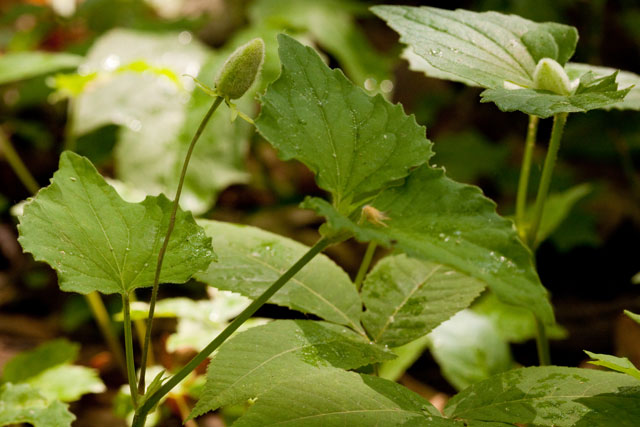 Downy yellow violet. May 27, 2009. Highbanks Metro Park. Delaware County, Ohio. It certainly appears as though violet has stopped blooming now that the canopy is closed and the woods are shady. But violets "secretly" continue blooming during late spring and summer with tiny flowers that lack petals, never actually open, and self-pollinate. These are cleistogamous ("hidden marriage") blossoms, and they constitute the basis of most of the plant's annual seed output. The picture below shows (slightly left of center) one such cleistogamous flower. It looks like a bud, but it's a flower...as big and showy as it ever gets. (On the upper right a young fruit is developing from the self-pollination of another cleistogamous flower.) 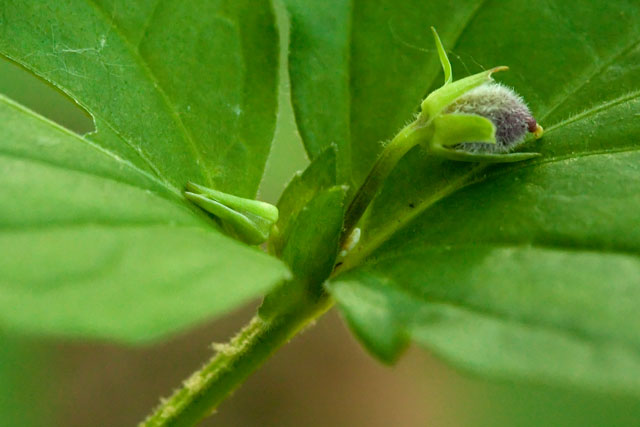 Downy yellow violet
cleistogamous flower and fruit.
May 29, 2009.
Highbanks Metro Park. Delaware County, Ohio.
Here's a studio shot of the same thing. One
or two
foreground stipules (stipules are paired leaf-like appendages that
appear at the base of some leaves) has been removed to better show the
flower.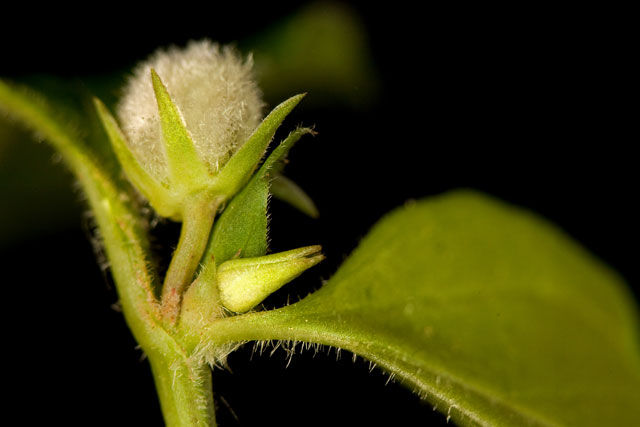 Cleitogamous flower and fruit of Viola pubescens. In these cleistogamous flowers, only the lower two stamens --the ones that come into contact with the stigma --are well developed; the other 3 are rudimentary, lacking anthers. Like scandalous shots on the cover of a sleezy grocery store tabloid, the picture below shows a flower from which three sepals have been removed to expose Violet's secret marriage. Note the wooly ovary topped by a short curved stigma that is nestled snugly against a pair of stamens (one visible, just barely). Not only do these flowers not open, but even the stamens don't open or actually release pollen. The pollen grains germinate within the anthers. The resulting pollen tubes grow out through the upper anther wall, directly into the stigma! 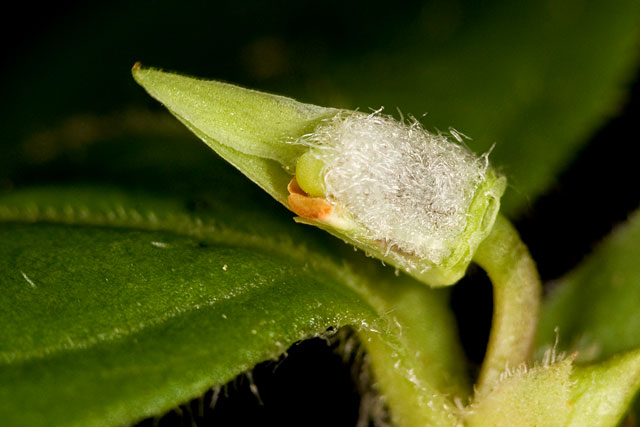 Partly dissected cleistogamous flower of Viola pubescens. Viola pubescens
comes in two
varieties, differing in the pubescence of the ovary. It seems that most
of the
plants in our area, including the one above, represent the form with a
white-hairy-ovary, var. pubescens, while a smaller
proportion of the plants have a completely glabrous (hairless) ovary
that is characteristic of var. peckii.
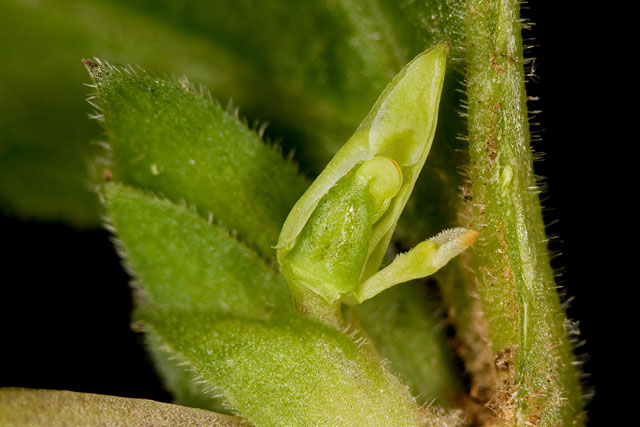 Cleistogamous flower of Viola pubescens var. peckii. Foreground sepals removed to expose the sexual parts of the flower. One stamen has been teased away from the pistil to show its structure. Note the broad filament extending beyond the anther-sacs. The showiness of the early spring violet flower is a mechanism to promote outcrossing, i.e., mating with other individuals, possibly over great distances. Compared to self-pollination, outcross-derived offspring are generally superior. But outcrossing comes at a cost, because the structures required to attract and reward bees deplete resources that could be used for other purposes, such as making more seeds. Also, pollinator-mediated reproduction is unreliable. If bees are scarce, then the violet might have few children. To achieve both benefits --genetic variation AND multiplication --many organisms have separate components of the life cycle devoted to each. For the violet, the showy flowers serve to generate genetic variation, and the cleistogamous ones serve to produce a great number of fairly uniform offspring. Some wind-pollinated plants Columbus and Tipp City, Ohio May 23-24, 2009 Narrow-leaved plantain (Plantago lanceolata, family Plantaginaceae) is an annoying weed in lawns and other grassy places, as well as a pioneer in disturbed sites that aren't lawns. Plantain graces our roadsides, providing drivers with an interesting diversion from such mundane items such as other cars, red lights, stop signs, pedestrians, etc. 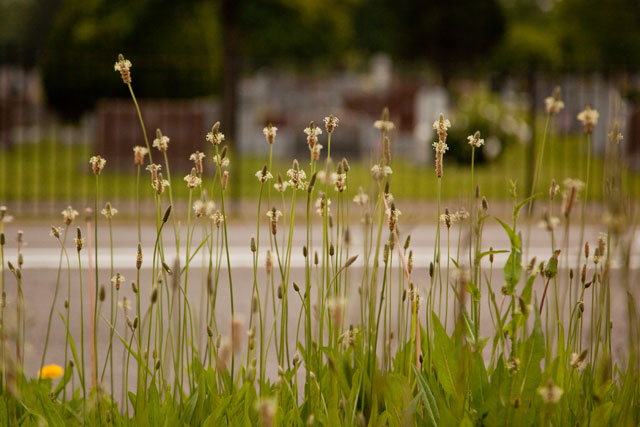 Narrow-leaved plantain in median strip of Columbus roadway. Mar 23, 2009. Plantain is a perennial herb with a basal rosette of narrow leaves, and many tiny flowers packed into spikes atop wiry scapes (leafless stalks with flowers at the top). 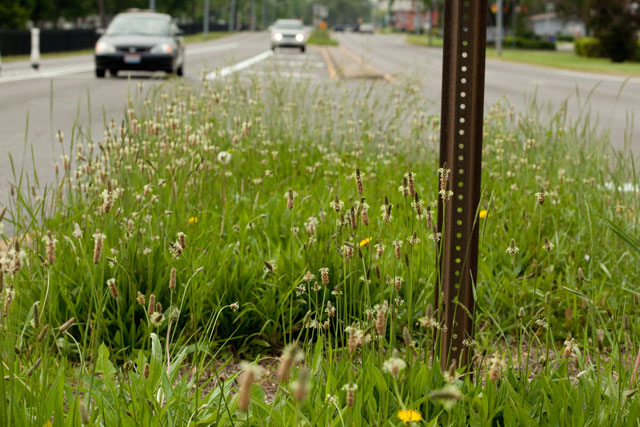 Narrow-leaved
plantain in median strip of Columbus roadway. May 23, 2009.
Narrow-leaved plantain flowers are protogynous ("female first"). They develop sequentially from the bottom of the spike towards the top. Hence the upper flowers are in the (earlier) female phase while the lower, older, ones have "been there done that" with respect to the female thing, and are now presenting stamens. 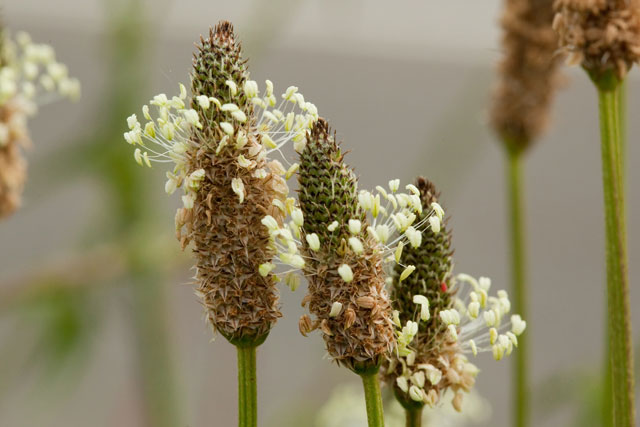 Plantain spikes. May
23, 2009. Columbus, Ohio.
Plantago flowers are 4-merous, with a calyx of 4 sepals, a corolla of 4 fused petals, and 4 stamens long-exserted on very slender filaments. The pistil consists of 2 fused carpels, topped by a stigma that is unbranched but, as is often the case with wind-pollinated stigmas, is somewhat plumose (feathery) to catch pollen grain whisking about. MOUSEOVER image to
see flower details
Plantain flowers are
protogynous, 4-merous, packd into compact spikes atop wiry scapes.
Although at first it
sounds crazy, the plantain family is taxonomically closely
related to the snapdragon (figwort) family, Scrophulariaceae.
Indeed, modern treatments consider them to be scrophs! But if
you compare these flowers to the 4-merous speedwell from
last week (scroll down), it doesn't seem quite so far-fetched. (The
4-merous
state of these scrophs is believed to be derived from a basic 5-merous
plan, by the fusion of two lobes.)
Nearby, orchard grass (Dactylis glomerata, family Poaceae) occurs along the same road. 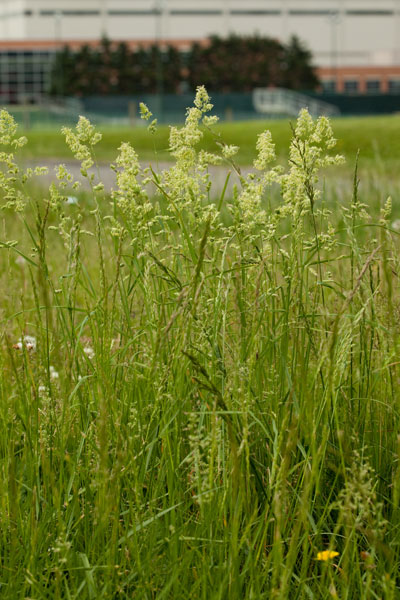 Orchard grass in roadside median strip. Columbus, Ohio. May 22, 2009. Orchard grass produces
its flowers in distinctive fist-like clumps at the ends of
side-branches that project squarely off the main stem.
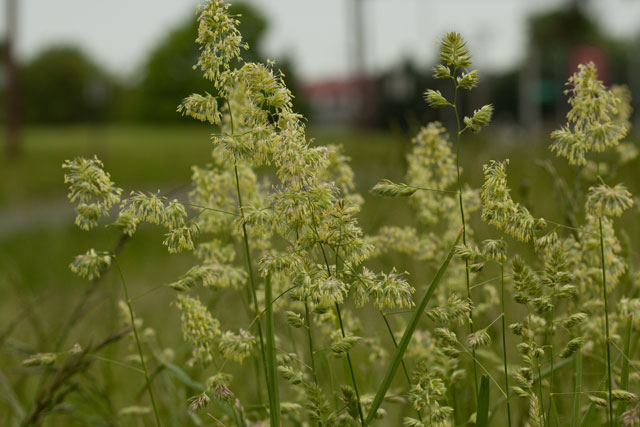 Orchard grass flowers. Columbus, Ohio. May 22, 2009. Grasses produce much-reduced flowers that entirely lack sepals and petals. The flowers are enveloped by paired tiny scale-like bracts. A grass bears stamens with large anthers at the ends of long slender filaments. Feathery pollen-receptive stigmas peek out from the paired bracts. Meanwhile, a few
counties to the southwest, in a woodland in lovely Miami
County, a sedge is setting fruit. This is Davis's sedge, Carex
davisii (family Cyperaceae). Like all carices (yes, for some
insane reason that is the plural of "Carex"), the
flowers are unisexual, and the plants are monoecious (a given plant
produces both male flowers and female ones). They are spirally
arranged, and the relative positions of the male and female flowers is
of diagnostic significance. Here, the staminate (male) flowers are
produced at the base of some spikelets that, at their tip, produce
female flowers (and eventually small one-seeded fruits called
"achenes").
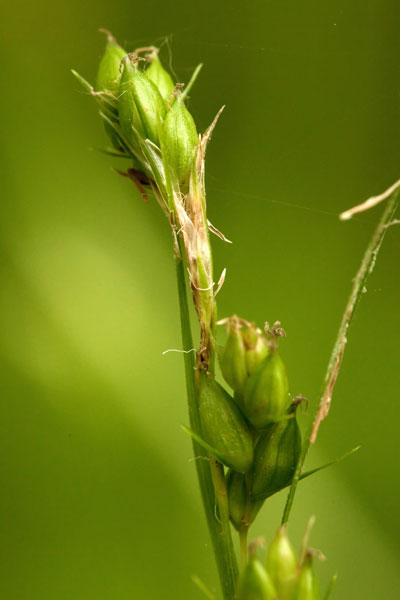 Davis's sedge showing terminal spikelet that is staminate at base, pistillate at top. May 23, 2009. Tipp City, Miami County, Ohio. Sedges in the genus Carex
have their female flowers, and ultimately the fruits, enclosed in a
papery sac, the perigynium.
The style extends
through a small orifice at the top of the perigynium, and the style
branches spread just above the perigynium to catch wind-borne
pollen. In the studio portrait
below, one perigynium is opened to show its stucture and reveal the
achene and its persistent style. Note also that each flower (including
the perigynium if it is pistillate) is subtended by a scale-like bract.
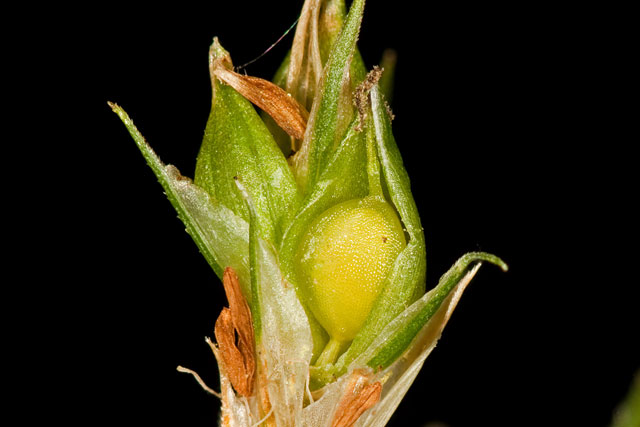 Davis's sedge showing perigynium opened to reveal achene inside. At the edge of the
woods, a hickory tree is releasing pollen from its numerous staminate
catkins.
Shellbark hickory,
with a little musical encouragement, sends pollen into the world.
May 22, 2009. Tipp City, Miami County, Ohio. Marion, Ohio. May 22, 2009 Irises (genus Iris, family Iridaceae) are perennial monocots with sword-shaped leaves and very showy flowers subtended by spathe-like bracts. A patch of large and strikingly beautiful blue flag iris stems is growing alongside a small pond at the Larry R. Yoder Prairie on the campus of Ohio State-Marion. 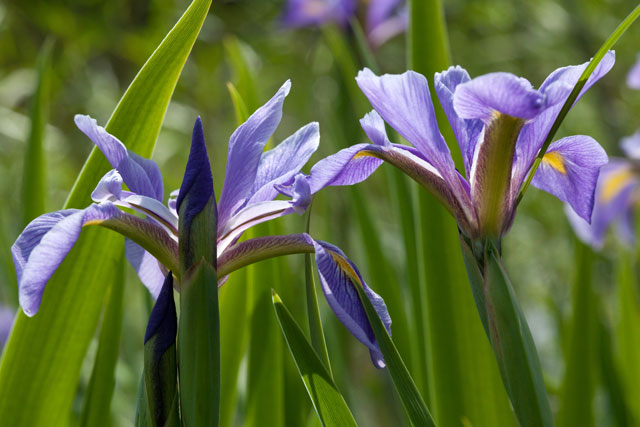 Iris flowers alongside pond in Marion, Ohio. May 22, 2009. Iris flower structure
is surprising.
Instead of having green sepals like most flowers, the outer
perianth segments (3 sepals) as well as the inner ones (3 petals) are
colored.
(The sepals are somewhat larger than the petals.) Big whoop, you
say...almost all members of the lily family (Liliaceae, with their
"tepals") are like that, right? But wait there's more. If you
call right now, using the toll-free number at the bottom of your
screen, we'll send you, absolutely free,
three style branches that also petaloid! The expanded colorful
styles arch over and run closely parallel to the
sepals.
As each style branch runs closely over a sepal, a copiously pollen-producing stamen lies sandwiched between the two of them. As its pollinator --some type of bee --forages for nectar at the base of a sepal, she slips beneath the stamen/style part of the sandwich, depositing pollen on the stigma, and picking some up from the stamens. Irises have an inferior
ovary, i.e., it is
situated below the other flower parts. From the outside it looks merely
like a swollen
pedicel, but a cross-section reveals the ovules (future seeds) within.
This photo shows a flower with all parts removed except for the pistil,
and the ovary sectioned lengthwise to reveal the ovules within,
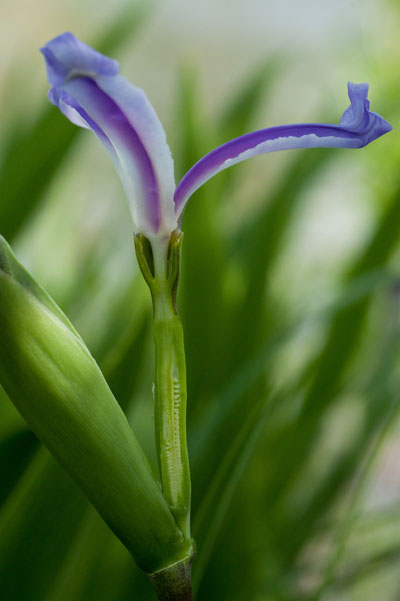 Iris with ovary longi-sectioned. May 22, 2009. Marion, Ohio. What species of iris is
this? It doesn't seem to match any either of the two possible native
blue Iris species, as the sepals lack the pubescent
(hairy) orange blotch at their base diagnostic of the southern
blue flag, I. virginica, yet the ovary
seems a bit too long --approx. 3 cm as opposed to 1-2 cm
--for it to be the northern blue flag I. versicolor.
Maybe its a garden escape, or the blotch is there, but indistinct.
Incidentally, although these pretty blue flags were seen along the shore of a pond, blue flags are also sometimes seen in woodlands, especially ones where plant ecology research is underway. 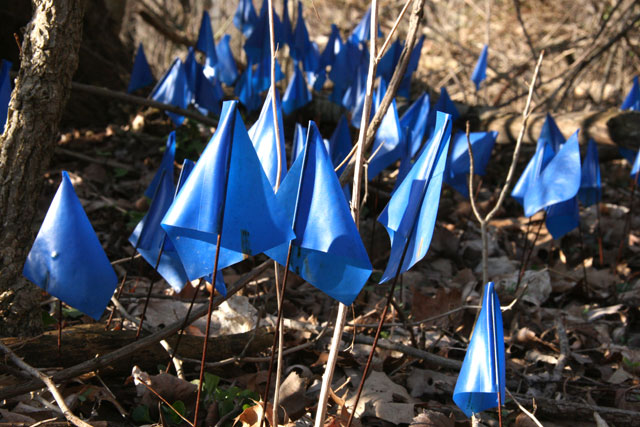 Woodland blue flags. April, 2008. Delaware County, Ohio. A cute fruit --purslane speedwell-- Pleasant, Marion County, Ohio. May 15, 2009 The genus of
wildflowers (Veronica)
collectively
termed "speedwells" are members of the snapdragon family
(Scrophulariaceae). With their nearly equal-sized (actinomorphic) and
spread-out (rotate) petals, they don't look very much like snapdragons
or most other members of the Scrophulariaceae, the blossoms of which
are
often strikingly bilateral and tubular. Several speedwell species are
low-growing but aggressive agricultural weeds, including this one seen
at the edge of a newly-plowed farm field in Marion County, Ohio --
purslane speedwell, V. peregrina.
Purslane speedwell. May 15,
2009. 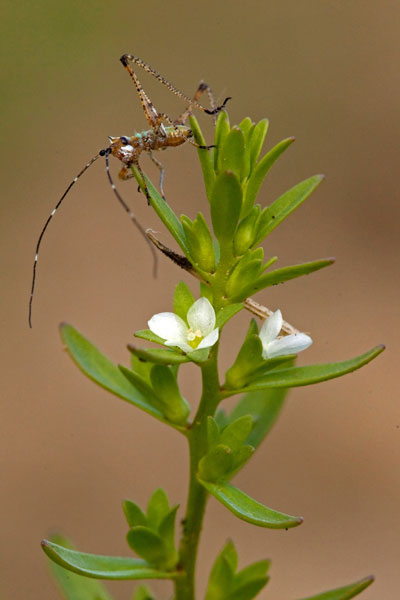 Pleasant Township Park, Marion County,Ohio. The speedwell fruit is
a winsome little Valentiney heart-shaped capsule, surrounded by 4
sepals,
and topped by a remnant of the style.
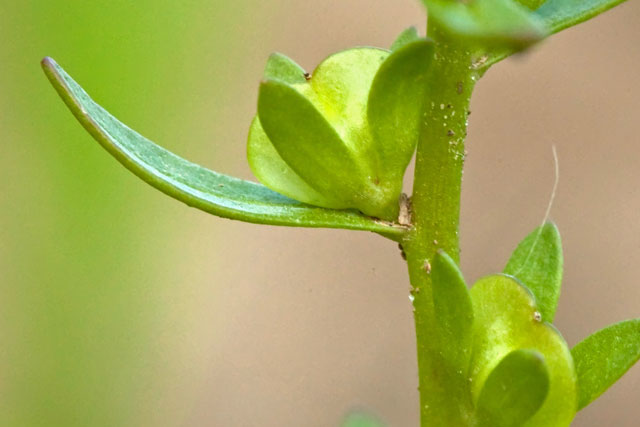 Purslane speedwell fruit. May 15, 2009. Marion County, Ohio. Nearby, one of our most
common sedges, the loose-flowered woodland sedge (Carex
laxiflora,
family Cyperaceae) is growing. This species bears wholly
separate staminate (male) and pistillate (female) spikelets. This
specimen's single staminate spikelet is the brownish-green
spear-shaped item extending above the top of the plant, while the other
three, bright green, spikelets are pistillate.
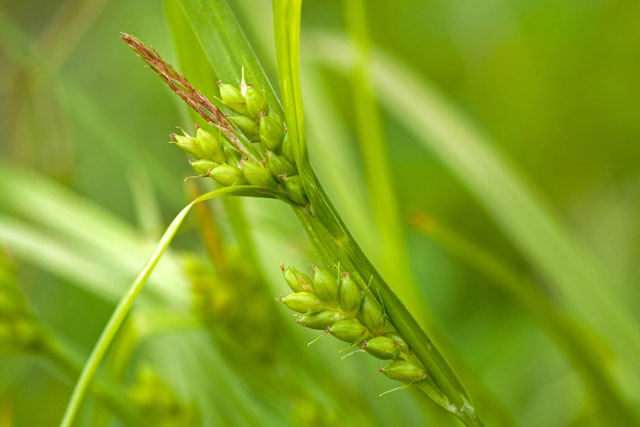 Loose-flowered woodland sedge. May 15, 2009. Marion County, Ohio. Sedges in the genus Carex
are
distinguished by having their small dry one-seeded fruits
(achenes) enclosed in an expanded bag-like structure, the perigynium.
At this stage (late flowering, with fruits not ripe yet) the 3 filiform
styles are visible extending out from the narrow orifice at the top of
each perigynium.
Loose-flowered woodland sedge. Marion County, Ohio.
May 15, 2009. 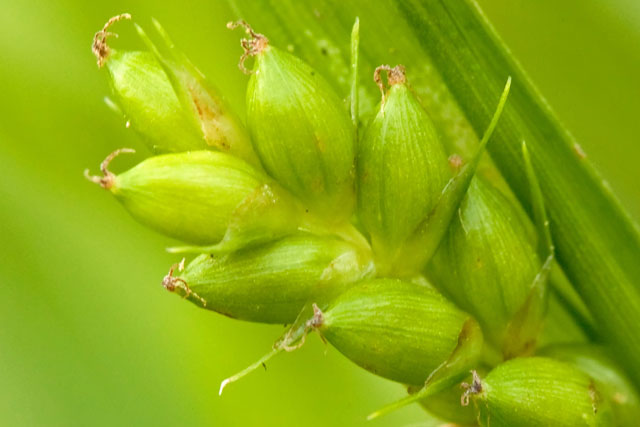 Dirty trees! (stuff that falls off trees that isn't leaves) Shumard oak --May 9, 2009 In the Clintonville
neighborhod of
Columbus, various red oaks --the sub-genus of oaks that have
bristle-tipped leaves (unlike the rounded lobes of the white oak
group), and acorns that take two years to mature (white oaks only take
one year) --are common as street trees. Pin oak, northern red oak, and
Shumard oak are all present. Like many trees, the oaks are
wind-pollinated, and produce their numerous tiny male flowers in
drooping catkins. These litter the gound after the pollen is shed.
Shumard oak (Quercus shumardii, family Fagaceae), one of the largest red oaks, has a generally southern and coastal plain distribution. It extends very sparingly into southwestern Ohio. It does well as a street tree. Until 18 years ago when it was stuck by lightning, Ohio's largest specimen lived in a backyard just 2 blocks away from this tree-lind street, so I think these are Shumards. The leaves look right. 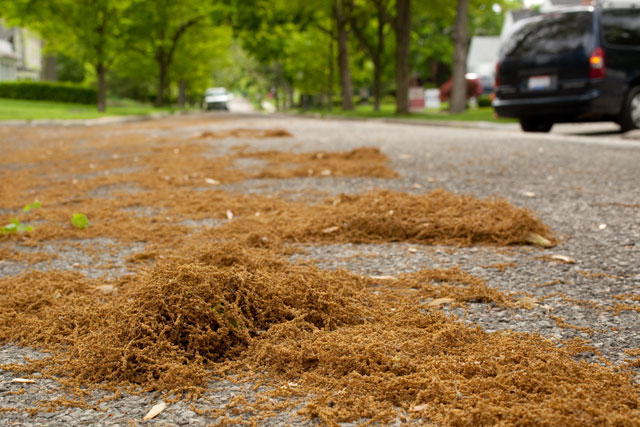 Shed staminate catkins of possible Shumard oak. May 9, 2009. Columbus, Ohio. A lot of trees have
been litterbugs this
spring. For the latest, follow this link (a new page on the "Dirty
Trees" section of this web site).
Crusading crucifers! Marauding mustards! Messes of cresses! (Various roadside Brassicaceae and a lovely woodland native one) (...and a cameo appearance by springtails...) Very late April and the 1st week of May, 2009 Delaware and Marion Counties, Ohio The plant family
Brassicaceae (mustard
family) is easily recognized. Also known as Cruciferae
--"cross-bearing" --the 4 separate and equal-sized petals set its
members apart from most other plants flowering now. There
are 78
mustards in Ohio, making it the 6th most specious family. Many
of them
are spring-flowering field and roadside weeds. This week, vast expanses
of cropland waiting for the season's plowing and planting are covered
with alien mustards. One of them constitutes great swathes of yellow.
This is early winter cress, Barbarea vulgaris.
Smooth rock cress. April 28,
2009. 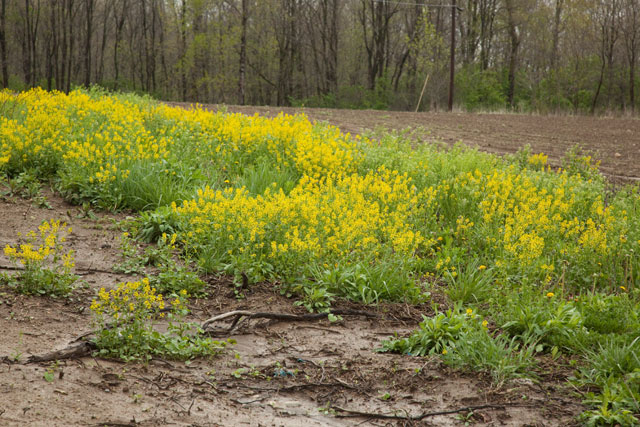 Early winter cress. May 1, 2009. Delaware , Ohio. Early winter cress is
recognized in part
by its deeply divided lower leaves and elongate racemes of yelllow
flowers. It is a usually a biennial, over-wintering as a rosette of
leaves with a modest taproot storing resources drawn upon by
the plant to flower
abundantly so early in the season.
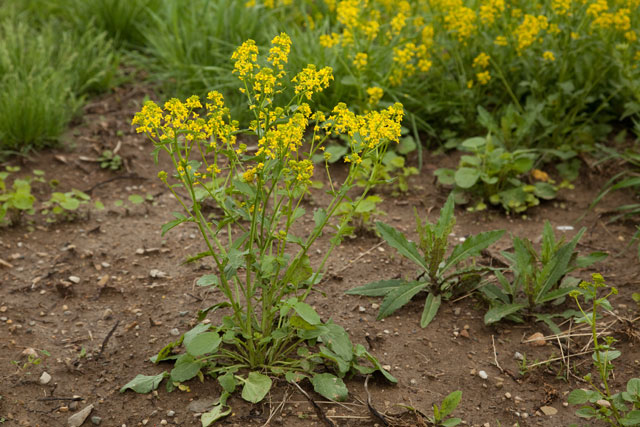 Early winter cress. May 1, 2009. Delaware, Ohio. Flowers of the
Brassicaceae have 4
separate sepals, 4 separate petals, and six stamens (barely visible in
one of the flowers below).
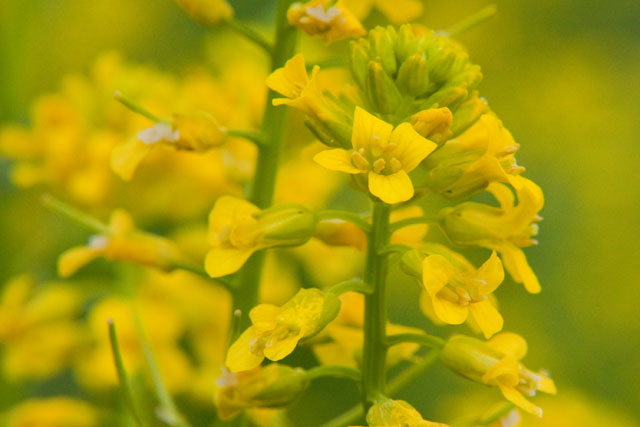 Earlywinter cress. May 1, 2009. Delaware, Ohio. Mustard family members
have an unusual
fruit type, a weird 2-chambered capsule with a partition inside
that cuts across, rather than separating, the individual units
(carpels)
of which it is composed. That is a technical distinction, all but
invisible, but it gives the mustard fruit its own special name, the silique.
To be more specific, the term silique
is used when it is long and narrow (sleek? ...evident in the fuzzy
background in the winter cress closeup), while short squat siliques are
called silicles. Appearing
alongside the winter-cress are two more weedy mustards, both
of which produce silicles: field peppergrass (Lepidium
campestre), and field penny cress (Thlaspi arvense).
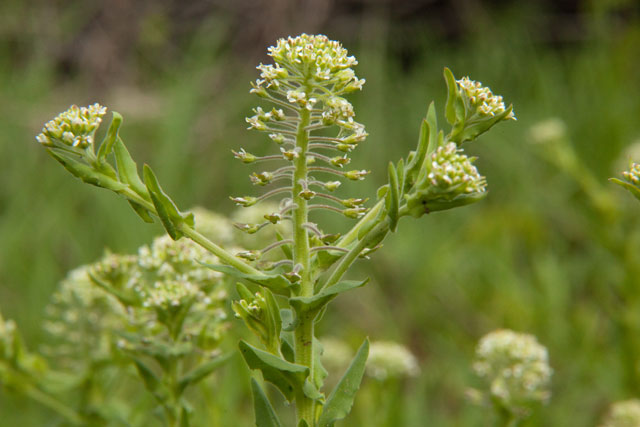 Field peppergrass. May 1, 2009. Delaware, Ohio. Field penny cress
siliques are much larger than those of peppergrass.
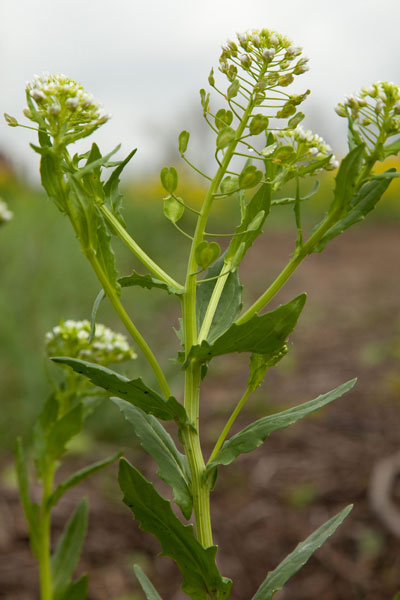 Field penny cress. Delaware Ohio. May 1, 2009. In adjacent Marion
County field penny cress consitutes
great swathes of white.
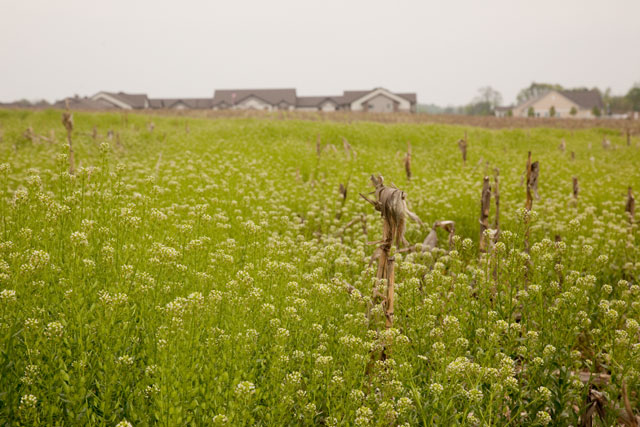 Field penny cress. Marion, Ohio. May 8, 2009. Tumble mustard (Sisymbrium)
is a
low-growing yellow-flowered annual weedy mustard that produces the
sleekest siliques imaginable. Moreover, it disperses as a tumbleweed!
After maturity the entire plant breaks away from the ground and is
blown
across the landscape, distributing seeds along the way.
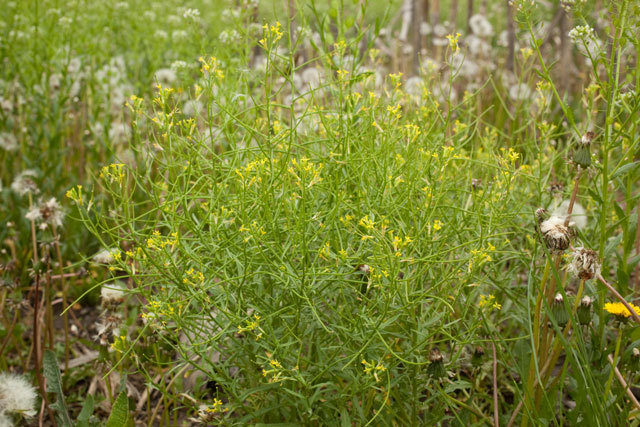 Tumble mustard. May 8, 2009. Marion, Ohio. 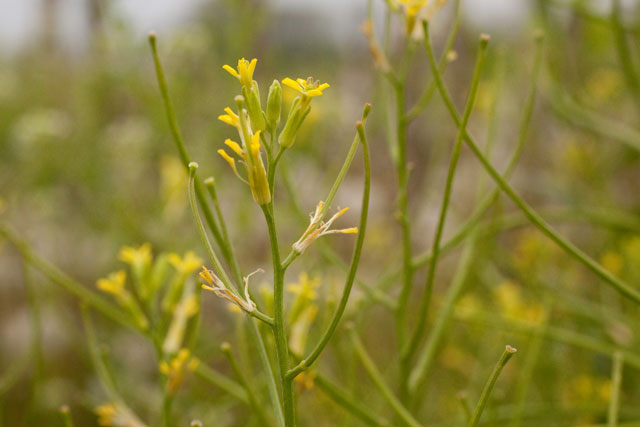 Tumble mustard
flowers and young fruits. May 8, 2009. Marion, Ohio.
Not all mustards are
weeds. There are some lovely native wildflowers. One of them is smoth
rock cress, Arabis laevigata, seen growing on a
shale ledge in the woods at Highbanks Metro Park in Delaware, Ohio.
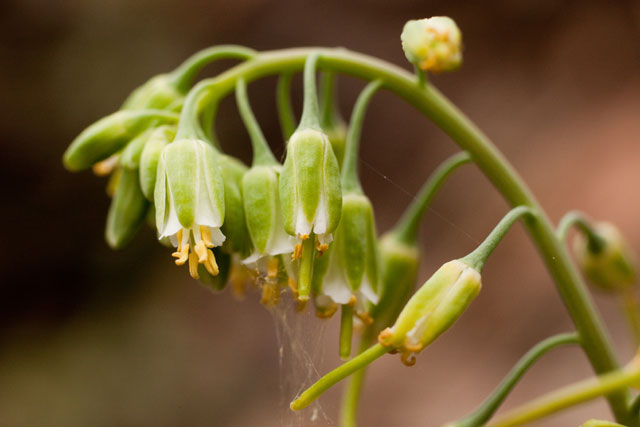 Smooth rock cress is
also called "sickle-pod" as is siliques are extremely long and
elegantly curved.
Smooth rock-cress developing
fruits. April 28, 2009.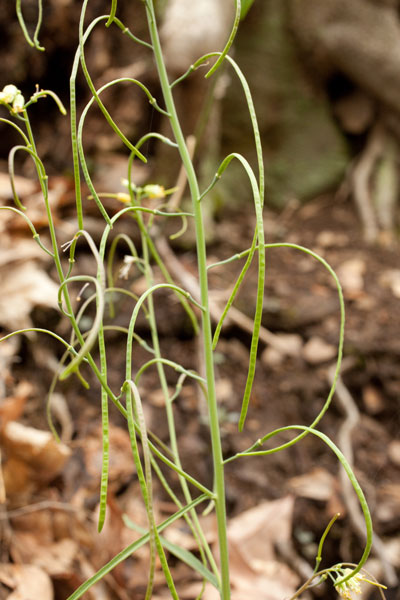 Highbanks Metro Park, Delaware, Ohio. While the smooth rock
cress was flowering
15 miles away, but really having nothing to do with the mustard family
of plants, springtail insects clambered about a mossy landscape on a
little brick wall in Columbus. The moss isTortula papillosa.
Can anyone ID the springtails?
Woodrush (Luzula multiflora) --the other graminoid! Hocking County, Ohio May 1, 2009 "Graminoid" is a general term for any grasslike plant, a member of one of three families characterized by narrow stems, linear leaves, and tiny wind-pollinated flowers. Comprising the order Poales within the monocots, these include actual grasses (family Poaceae), sedges (Cyperaceae), and rushes (family Juncaceae). Of the three, rushes are the least numerous and thus not as generally well known as grasses or sedges. There are two rush genera in our area: Juncus ("rush" in the strict sense with many seeds per capsule and plants hairless) and Luzula ("woodrush," with only 3 seeds per capsule and plants more or less hairy). In an open mixed hardwood forest at Deep Woods Preserve in southern Ohio's Hocking County, common woodrush (Luzula multiflora) is currently blooming. 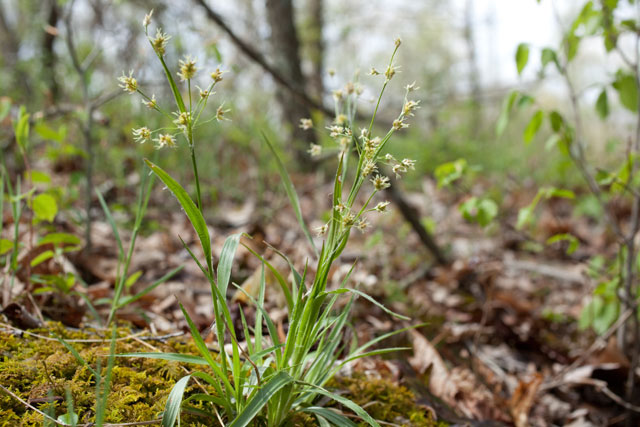 Common
woodrush. May 1, 2009. Hocking
County, Ohio.
The flower of a rush, unlike the highly modified flower of a grass or sedge, is fairly straightforward. Although the Juncaceae isn't placed especially close to the lilies (Liliaceae) in a modern classification scheme (they're in different taxonomic orders), it sure seems like it should be! Indeed, older manuals placed the Juncaceae alongside the Liliaceae in the Order Liliales. A rush flower looks exactly like a lily flower in perfect wind-pollinated miniature. Each has a superior ovary, regular symmetry, a perianth of three separate sepals and three separate petals that resemble one another ("tepals"), an androecium of 6 stamens, and a syncarpous gynoecium composed of three carpels topped by 3 stigma branches developing into a capsular type of fruit with 3 chambers (locules). The flowers practically scream "Lily"! (Or at least whisper it, as they are quite small.) I don't get it. If dodder is a miniature morning-glory, why aren't rushes miniature lilies? Here's a closeup of the woodrush flower cluster. Note the flower parts in threes or multiples thereof (six stamens). Emerging from within each ring of stamens is the style with three feathery pollen-receptive stigmas. This appears to be an instance of protogyny ("female first") wherein the female parts mature before the male ones. (See how the stamens haven't yet split to release their pollen.) Protogyny is a mechanism to reduce self-pollination. 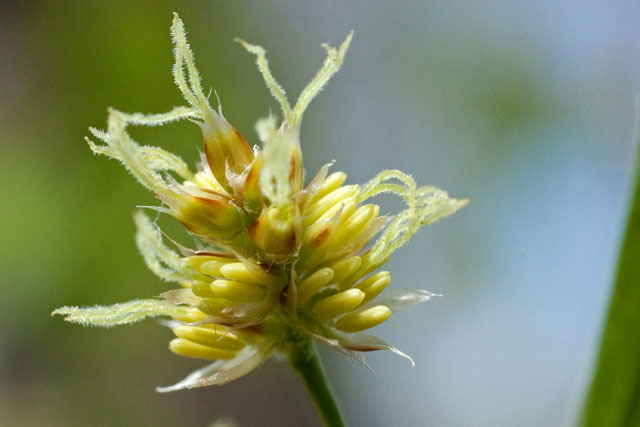 Woodrush (Luzula) flower cluster. May 1, 2009. Hocking County, Ohio. Meanwhile, along a
nearby roadside farfaraway,
coltsfoot plants have advanced to the fruiting stage and we see why,
not looking carefully, you might mistake them for dandelions. Even the
fluffy heads look different though. They're equally fluffy,
but
fluffy in a different way.
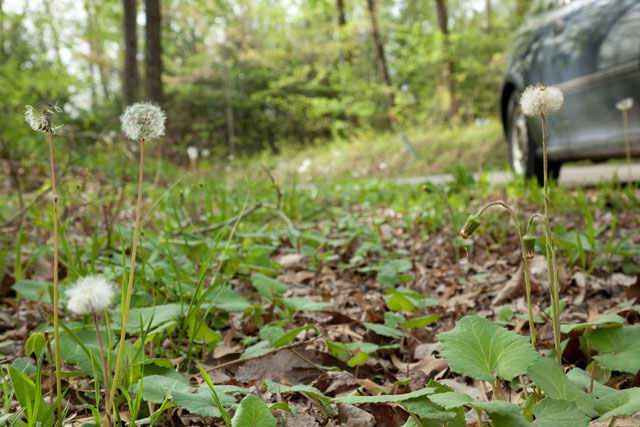 Two fruiting weeds in the Aster family. May 1, 2009. Hocking County, Ohio. Left: dandelion (Taraxacum officinale). Right: coltsfoot (Tussilago farfara). Fluffy in a different way? Yes. Dandelion/coltsfoot "fluff" is the pappus --the highly modified calyx (sepals) of members of thr Asteraceae. In both these genera the pappus is composed of numerous hairlike ("capillary") bristles that facilitate wind dispersal of the single-seeded fruits. Hoever, the Taraxacum (dandelion) pappus bristles are fused into a single stalk that extends from the apex of the single-seeded fruit and at its tip spreads into separate bristles, whereas the pappus of Tussilago (coltsfoot) bristles are simple and separate for their entire length. 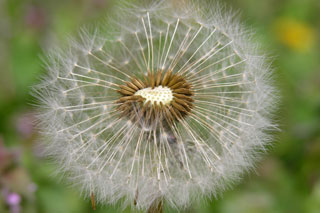 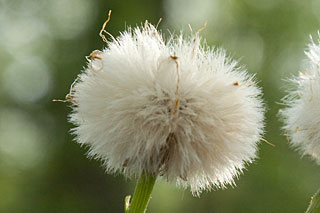 Fruiting heads of two asteraceous weeds. Left: dandelion. Right: coltsfoot. 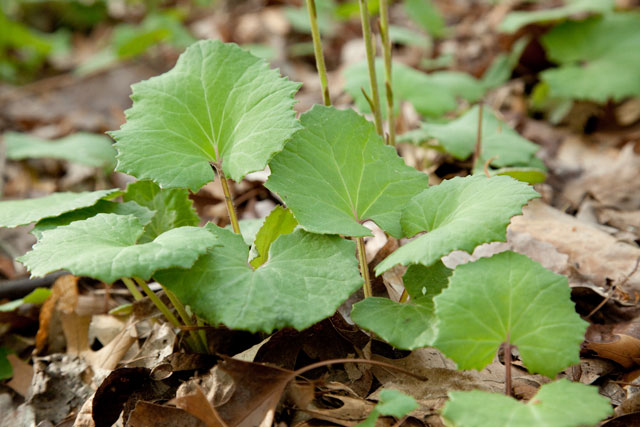 Coltsfoot leaves suggestive of equine hoofprints. May 1, 2009. Hocking County, Ohio. American
sycamore --the eastern sequoia!
Columbus,
Ohio
April
30-May 7, 2009
American sycamore (Platanus
occidentalis, family Platanaceae) can be thought of as our
"sequoia"
--an ancient and superlative tree, huge, distinctive, spectacular, and
well-loved. Among eastern
trees, tuliptree (Liriodendron) is
occassionally taller, but by combining exceptional girth and height,
sycamore is our most massive tree. Pioneer families sometimes lived
inside hollow ones whilst their cabins were being built. In Birds
of America (1840) John James Audubon recounts how
he hired
someone to cut a hole through the base of one densely occupied by
chimney swifts in Louisville, Kentucky so that he could inspect the
nests. Audubon estimated that 9000 birds roosted in that single tree!
American sycamore is a forest giant that is also a beloved lawn and street tree. Incidentally, the modifier "American" is helpful with this tree because in Europe, "sycamore" refers to a species of maple (Acer pseudoplatanus), while the common name "plane-tree" is employed for old-world Platanus species. An American sycamore in the Clintonville neighborhood of Columbus has branches conveniently situated to enable a close look at its flowers. 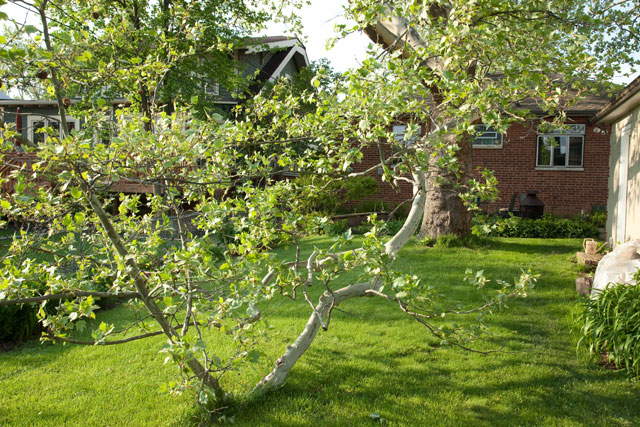 American sycamore, Columbus, Ohio. May 6, 2009. The architecture of this specimen is interesting. A low branch extends 40 feet from the trunk and touches the ground, but just barely. It's actually free to move in a breeze. 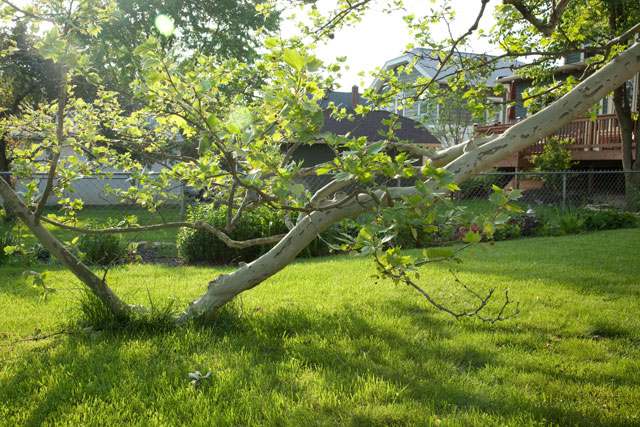 Low branch of American sycamore. Columbus, Ohio. May 6, 2009. American sycamore is
flowering now. The trees are monoecious and wind-pollinated, producing
numerous tiny flowers all of one sex in
dense globose clusters produced singly in the axils of leaves.
The staminate heads, at least in this example, are much more numerous
than the pistillate ones.
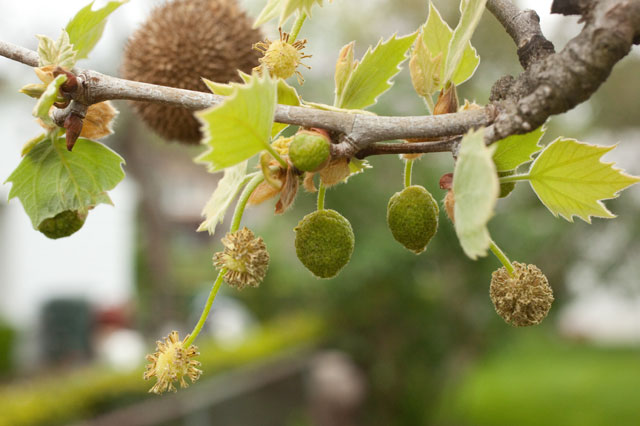 American sycamore staminate heads before (center of photo) and during/after (side heads) dispensing pollen. April 30, 2009, Columbus, OHio. Other than the pollen-producing anther portion of the stamens, all the parts of the individual male flowers are very small and difficult to distinguish. The pollen maturation and associated dispersal process is remarkable. Each stamen consists, as is typical, of a pair of pollen sacs located alongside one another. Here, the two pollen sacs are connected at the top by an expanded and centrally attached "peltate connective" that is contiguous with all the other flowers' peltate connectives, causing the the staminate heads to start out smooth, firm, and effectively sealed shut which the pollen inside the head is becoming mature. The anthers split longitudinally, and the pollen is finally released when the anthers fall from the inflorescence! Here are studio shots of an immature staminate head. This one is fresh from the tree. 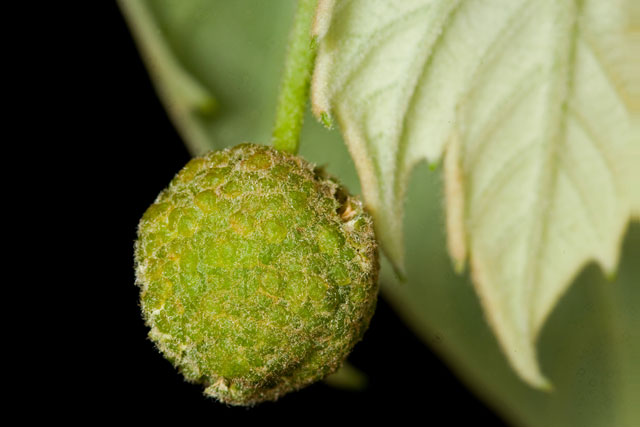 American sycamore staminate head. May 7, 2009. ...and this is a
cross-section. Note the expanded peltate connective lying atop each
stamen, abutting the others to seal the ball shut while the
extremely long narrow anthers split lengthwise, releasing copious
amounts of pollen. There are said to be 3 to 7 minute sepals, and an
equal number of tiny petals. Good luck finding them.
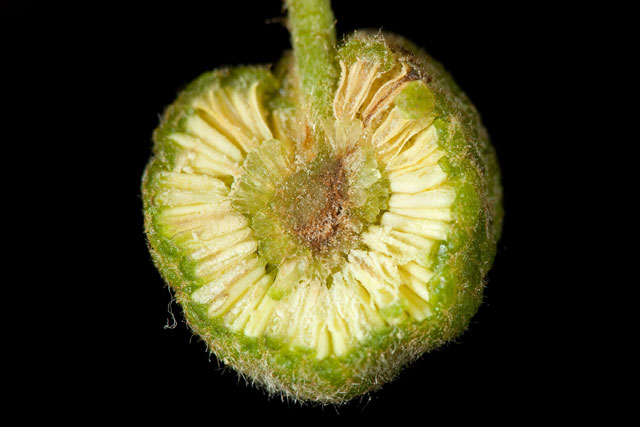 American sycamore staminate head. May 7, 2009. The pollen is dispersed as the male heads fall apart. Here's one at the onset of that process. 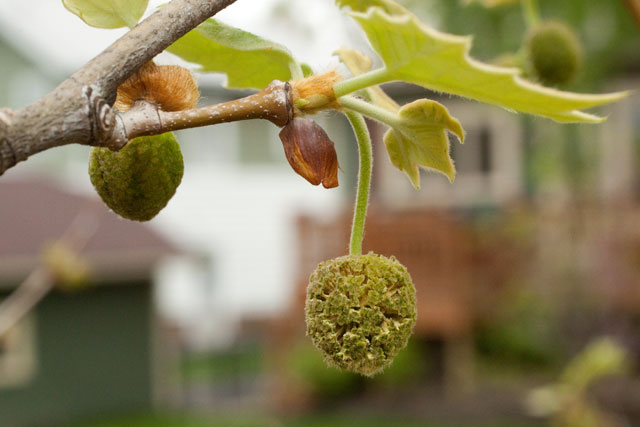 Sycamore staminate head disarticulating. April 30, 2009. Columbus Ohio. ...and a
closeup
view, in the studio.
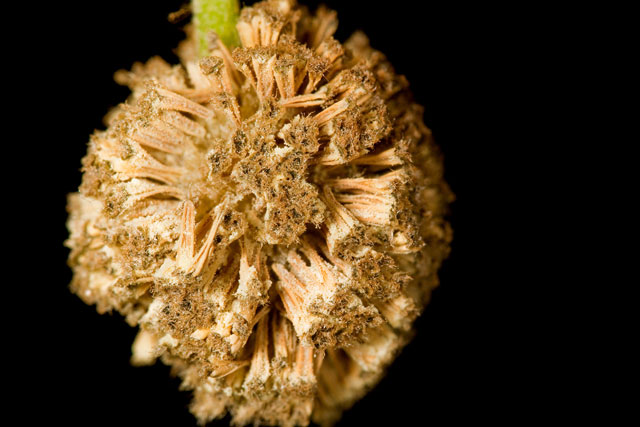 Sycamore mature staminate head. May 7, 2009. Here's the best part. Dirty trees!!! The stamens are shed, and they rain onto streets and sidewalks. 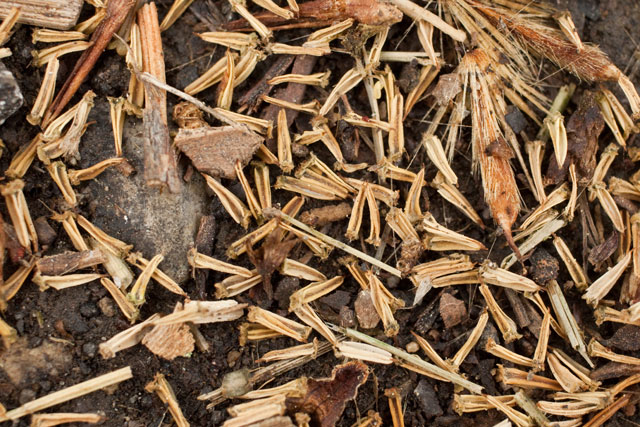 Shed sycamore stamens litter the ground. April 30, 2009. Columbus Ohio. On average, the much
less numerous
pistillate (female) heads have been in flower a bit longer than
the male ones as the species is protogynous --the female flower
parts develop before the male ones, a mechanism to reduce
self-pollination.
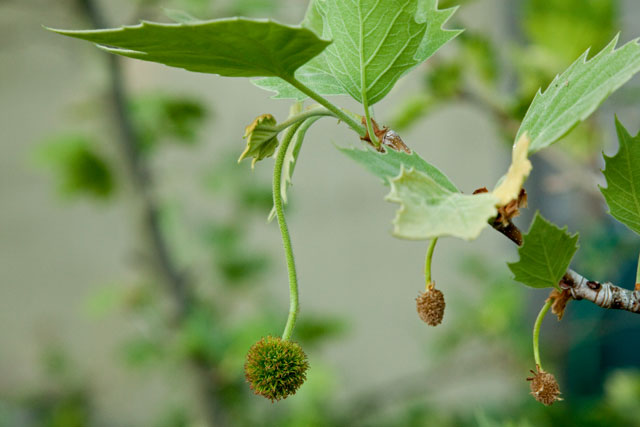 Sycamore pistillate flower head. May 7, 2009. Columbus, Ohio. ...and here's a closeup
view of a pistillate head in the studio. It's very stylish.
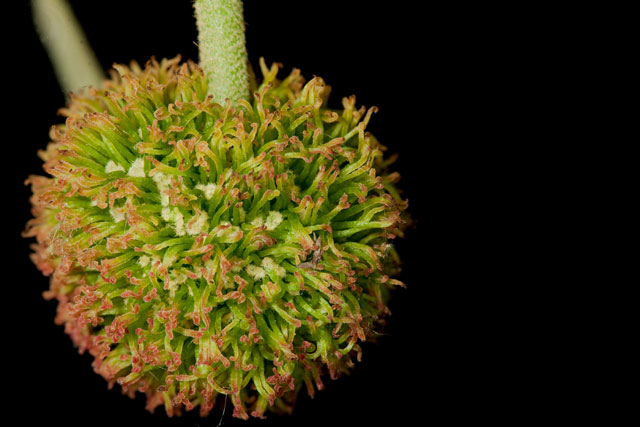 Sycamore pistillate head. May 7, 2009. The pistillate flowers
are described as
being apocarpous, consisting of separate 5 to 9 separate carpels. There
are no petals. The 3 to 7 sepals are minute. There are said to be
"staminodes" (reduced sterile stamens); these might be the
fluffy-looking things mixed in with the carpels.
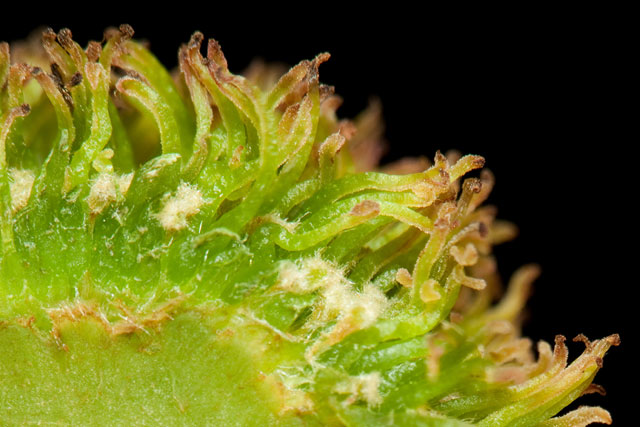 Sycamore pistillate flowers. May 7, 2009. By the end of the
summer the pistillate
heads will have matured into the familiar ping-pong-ball sized
aggregate of achenes that is the basis for several other
common names of
the plant: buttonwood tree, and button-ball tree.
|
